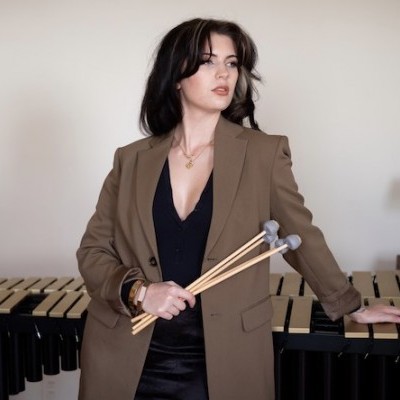Jun 3, 2025 11:25 AM
In Memoriam: Al Foster, 1943–2025
Al Foster, a drummer regarded for his fluency across the bebop, post-bop and funk/fusion lineages of jazz, died May 28…

María Grand’s new disc is being released through Biophilia Records.
(Photo: Pedro Gil Rosas)On the first full-length album from Swiss saxophonist María Grand, the human voice is presented with equal importance and urgency as her trusty tenor. While guests like Jasmine Wilson and Amani Fela bookend Magdalena (Biophilia) with poignant spoken-word introspection, it’s the evolution of Grand’s vocal prowess and her approach to the horn that drive the soul of this 11-song collection.
“As I study the voice more, it’s changing my tone on the saxophone, because I’m learning to get a fuller tone on my voice,” she explained. “I’m trying to get the same vibration in my chest, and I’m noticing it’s giving me more of a vibrato. So, I’m playing a little bit louder and I’m getting into more intense playing.”
Backed by her core rhythm section of bassist Rashaan Carter and drummer Jeremy Dutton with guest turns from guitarist Mary Halvorson and pianists David Bryant and Fabian Almazan—whose ecologically minded imprint released the album—Magdalena presents a more confident, assured performer and composer than who first emerged on her 2017 debut EP, Tetrawind (Self Release). Her tenor playing on instrumental tracks like “T1: Isis,” “Pyramid Sphere” and “Demonium” alone demonstrate Grand’s deep appreciation for Charlie Parker and John Coltrane, though there’s an element of sweetness in her tone that might bring to mind Paul Desmond or Grover Washington Jr.
“My father used to play a lot of Coltrane around the house,” she recalled. “When I was a kid, I really liked Jazz At Massey Hall with Charlie Parker, Dizzy Gillespie, Bud Powell, Max Roach and Mingus, who overdubbed the bass on it; but I didn’t know then. Also, when I was growing up, I loved Stan Getz’s bossa nova records. It’s funny; I don’t listen to these things too much anymore. But I listened to them all the time when I was a kid, maybe 10 years old.”
Listening to “Imani/Walk By” and the luminous Halvorson duet “Sing Unborn,” the way Grand has grown as a singer in balance with her skills on the reeds is unparalleled, something she attributes to her love for Brazilian music.
“I’ve always listened to a lot of singers throughout my life,” she said. “I grew up listening to Billie Holiday and Dinah Washington, and I listen to a lot of Elis Regina. For my voice, I guess I’m more like Elis, because I don’t have the type of vocal range that Dinah Washington has. I also listen to a lot of João Gilberto; I really like his use of the voice. Brazilian composers are a big inspiration for me, as well, like Sérgio Mendes and Antônio Carlos Jobim.”
Guiding the thematic crux of Magdalena is Grand’s recent studies of pioneering family therapist Virginia Satir, whose research during the ’60s, ’70s and ’80s on coping and self-esteem within the construct of the family circle earned her numerous accolades.
“I’ve been studying Virginia Satir for about seven years,” she said. “The ways that people communicate with each other—and a lot of the way we learn to communicate as humans—is in the family structure when we’re children. She has a book called The New Peoplemaking, and there’s so much we do as adults that comes from what we did as children, and the way we communicated as kids in light of all the different messages we received.”
Grand is implementing this research into the magic of her music, as well as utilizing her studies of the “family constellation” in her burgeoning role as an educator, having recently taught a music workshop at the Kimmel Center for the Performing Arts in Philadelphia and at the Susan Wagner High School in Staten Island through pianist Arturo O’Farrill’s Afro-Latin Jazz Alliance.
“Usually children don’t come to music with that many preconceived ideas,” she said. “As we grow up and learn different things, we put these things into boxes and we label music as separate entities. Kids just hear it as music, and that’s my favorite part of working with children. You can just show them the saxophone, and that’s all it is. They don’t necessarily know the history of it and where the saxophone comes from, so there’s a lot of space for exploration. Some of the kids I was recently working with at a high school, they were so good and enthusiastic, and are really, really going to become great musicians. That’s really beautiful and inspiring for me, to see young people exploring new directions.” DB

Foster was truly a drummer to the stars, including Miles Davis, Sonny Rollins and Joe Henderson.
Jun 3, 2025 11:25 AM
Al Foster, a drummer regarded for his fluency across the bebop, post-bop and funk/fusion lineages of jazz, died May 28…

“Branford’s playing has steadily improved,” says younger brother Wynton Marsalis. “He’s just gotten more and more serious.”
May 20, 2025 11:58 AM
Branford Marsalis was on the road again. Coffee cup in hand, the saxophonist — sporting a gray hoodie and a look of…

“What did I want more of when I was this age?” Sasha Berliner asks when she’s in her teaching mode.
May 13, 2025 12:39 PM
Part of the jazz vibraphone conversation since her late teens, Sasha Berliner has long come across as a fully formed…

Roscoe Mitchell will receive a Lifetime Achievement award at this year’s Vision Festival.
May 27, 2025 6:21 PM
Arts for Art has announced the full lineup for the 2025 Vision Festival, which will run June 2–7 at Roulette…

Benny Benack III and his quartet took the Midwest Jazz Collective’s route for a test run this spring.
Jun 3, 2025 10:31 AM
The time and labor required to tour is, for many musicians, daunting at best and prohibitive at worst. It’s hardly…